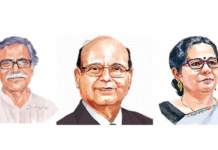
In June 2014, almost five years after the end of the longstanding civil war in Sri Lanka, violent clashes broke out in several small towns in the south, including Aluthgama, Beruwela, and Dharga Town. The tensions were fueled by reports that a Muslim man had allegedly attacked a Buddhist monk and several others, triggering a spate of violence, including the burning of Muslim-owned shops and attacks on Muslim homes and citizens. The incident is most likely the worst outbreak of Sinhala Buddhist-Muslim violence in recent times.
Since independence, conflicts and ethnic tensions have from time to time marred the usually peaceful, multi-religious, multiethnic country that most Sri Lankans aspire to be part of. Sri Lanka’s post-independence history is replete with leaders at all levels who have come to power riding on the fears of a Sinhala voter base. We have seen this from time to time throughout Sri Lanka’s history, but to date, no Sri Lankan leader has put forward a vision for a truly united, plural Sri Lanka. Instead, the rhetoric in the public space has more to do with the “tolerance” of minorities within a predominantly Sinhala Buddhist state.
Despite these emerging trends, I think it is important to recognize that after 30 years of war, throughout Sri Lanka there is still a deep yearning for peace and normalcy. People value the freedom of being able to travel anywhere in the island, to live and work without fear of suicide bombs and security checks, and get back to a normal life. The moment for an overarching idealistic vision for a more inclusive Sri Lanka came in May 2009 when the government could have used its overwhelming victory over the Liberation Tigers of Tamil Eelam (LTTE) to forge a new discourse on a multiethnic, multi-religious, and multilingual Sri Lanka. The country could have looked forward together, mourned the loss of Tamil and Sinhala sons and daughters and forged a common pluralistic future. But the path that Sri Lankan leaders set for the country, riding high on the euphoria of victory, was one of reestablishing the power of the Sinhala Buddhist majority and, in places like Aluthgama, these discriminatory forces have risen up to reveal the underlying fears of the majority community.
The recent emergence of issues with the Muslim community reveals a growing sense of alienation within yet another minority community. These feelings of alienation have been consistently articulated by various groups throughout the island, among the educated, unemployed Sinhalese youth in the South as well as among the lower caste young Tamils in the North-East. Sri Lanka’s post-colonial history has demonstrated that left unaddressed, such feelings of political alienation and discrimination can transform from a general sense of collective grievance to frustration, anger, and ultimately, mass violence. For Sri Lankans, the effects of this sense of collective grievance and alienation are particularly significant. The ingrained sense of discrimination that persists among various communities directly affects their sense of identity and colors their perceptions of their place in the nation’s social structure and their faith in the possibility of long-term reconciliation and peaceful coexistence in a country that has survived 30 years of war.
Feelings of grievance and discrimination are often exacerbated by the fact that different ethnic and religious communities in Sri Lanka tend to interact and socialize only among themselves. This is partially due to their monolingual nature and the language-based segregation of the education system. Communities outside of the multi-ethnic urban environment tend to exist in pockets of isolation, receiving information from monolingual media sources, forming relationships with only persons from their own ethnic group, and viewing other communities on the basis of long established biases and preconceived impressions. This tends to fuel antipathy toward other communities and creates invisible barriers between them.
Sri Lanka needs a new discourse of reconciliation and integration that is not based on externally driven agendas or diaspora aspirations, but one that builds on networks of civic solidarity that are prevalent in its communities through existing social bonds, community relations, and established civic associations.
As much as the outside world sees the discord and disintegration that is reported about Sri Lanka, over the past 20 years of working with The Asia Foundation in communities throughout the island, I see the endless opportunities where resilient communities cross religious, ethnic, and social barriers to co-exist and flourish. Community mediation boards, supported by the Ministry of Justice but led by community volunteers, meet every weekend in 328 locations, including now in the districts of Mullaitivu and Killinochci, to solve minor civil and criminal disputes at the local level; community policing forums meet monthly to discuss safety and security concerns; and local authorities prepare citizen report cards and present their findings to packed meetings in town halls to provide feedback on improving urban service delivery in their towns. Rotary Clubs, Lions Clubs, District Chambers of Commerce, and Trader’s Associations all flourish with multiethnic, multi-religious membership and leadership. This type of civic engagement at the local level can be the starting point of broadening the sense of self and community and moving beyond a parochial sense of grievance and alienation.
Whatever Sri Lanka has achieved since 2009 will all be for naught if we do not begin to value our diversity, celebrate our difference, and learn to live with each other as a multicultural, multiethnic society within a united Sri Lanka.
Dinesha de Silva is The Asia Foundation’s country representative in Sri Lanka. She can be reached at dinesha.desilva@asiafoundation.org. The views and opinions expressed here are those of the author and not those of The Asia Foundation.
Source: AsiaFoundation









